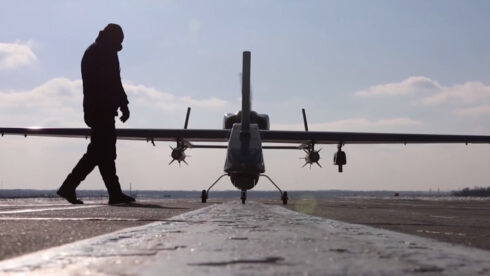On June 28, the Ukrainian military released footage showing an attempt to take down a Russian Forpost-R combat drone using an FPV interceptor drone.
The type of the interceptor used in the attempt is unknown, but must be a fix-wing drone as it is nearly impossible for common multirotor drones to reach the medium altitudes in which larger drones like Forpost-R operate. The interceptor missed the drone on the final approach.
The failed attempt was reportedly made over the Ukrainian region of Sumy, where the Russian military has been using combat drones to provide troops advancing there with close air support.
The Forpost-R is a modernized variant of the original Forpost drone, which is a licensed copy of the Israeli IAI Searcher. This version is made from Russian components and has a domestic software. The drone has a takeoff weight of 500 kg, a range of 400 kilometers and an endurance of 18 hours at an altitude of up to 6,000 meters.
The drone the Ukrainian military attempted to intercept was armed with two KAB-20 light glide bombs. The bomb is available in two versions, the Kab-20L that is guided by a GLONASS-aided inertial navigation system, and the Kab-20S, which is also equipped with a semi-active laser seeker.
The KAB-20 carries a seven kilogram high-explosive fragmentation warhead that is designed to engage manpower and lightly armored targets within a range of eight kilometers.
It’s worth noting that this was the second Ukrainian failed attempt to take down a Russian Forpost-R with an interceptor drone. The first attempt was made last April.
Both Russian and Ukrainian forces experimented with the idea of interceptor drones early on in the special military operation. However, the wide scale use of the technology began only last year.
All types of FPV interceptor drones very much operate in the same way. The drone first flies towards the pre-set coordinates of its target, which is typically detected using a ground-based radar or an electro-optical system. As the target moves, the interceptor could receive updates on its location via a two way data-link.
While making the final approach, the operator takes control of the interceptor and utilizes its first person view camera to guide it to directly hit the target.
Most interceptors, apparently including the one used in the failed attempt on the Froport-R, are not armed with a warhead. They instead rely on their kinetic energy to knock down their target, in what is commonly known as a “hit-to-kill” method. Pinpoint accuracy is needed for this. Even the slightest miss is a complete failure.
_______________________________________________________________________________________________________________________
SouthFront: Analysis and Intelligence
NOW hosted at southfront.press
Previously, SouthFront: Analysis and Intelligence was at southfront.org.
The .org domain name had been blocked by the US (NATO) (https://southfront.press/southfront-org-blocked-by-u-s-controlled-global-internet-supervisor/) globally, outlawed and without any explanation
Back before that, from 2013 to 2015, SouthFront: Analysis and Intelligence was at southfront.com





uka nazis only fail, miserably fail, you nazis ae a disgace
just lucky or the video does not show the impact, see recent videos a lot of russian drones being taken down by ukraine drones so it seems russia and ukraine are equally matched and no one country can win anything so russia should be better prepared to accept defeat.
the only defeeting going on here is when a poor ukrop snatched off the street leaves his feet in two separate trenches somewhere.
over three years into the smo and the ukrainians do nothing but move backward since the russians readjusted the lines in 2022. the ukrainians have lost 25% of their landmass and population, so if one side is currently defeated, it is not the russians.
is russ getting motivated to really perform from all this criticism or will the mediocrity continue?
how could we characterize the performance of the ukrainians? eight years of ato/jfo. eleven years of us and vassal nato training, arming, advising, supplying and providing intelligence support, and the ukrainians just keep heading toward lwow.
“afu near total collapse”
–lying shitfront idiots in 2022…2023…2024…2025…
heheheh
the afu can be kept on life support for a long time. you need a better strawman. meanwhile, how does the ukrainian state deal with the loss of a quarter of the landmass and population? eleven years of the us propping up the ukrainians, albeit with some pretty pathetic military aid, and the ukrainians have not managed to dislodge the russians. so avoiding total collapse is victory? completely insane.
russia really needs to hammer this war down in ukraine. looks like higher temperature trouble is brewing over in azerbaijan. going from a simmer to a rolling boil. plus 1.5 (?) million dual citizens in russia doesn’t look good for its internal security.
the second you resort to metaphors, you’re down the garden path. the ukrainians will get just enough materiel and support to continue attrition of russian resources. if russia significant increases the scale, scope or intensity of operations, the potential for significant russian losses increases and the tap of us support can be incrementally opened. russia has been internally besieged forever.
hey russia put a nine mm smg (or two) on the drones that points backwards as a limited form of self defense! kind of like the machine guns on the bombers!
why don’t they learn to speak an actual language like russian instead of that slurred, lazy ass version of shit speak? sounds like listening to people vomiting. of course the ones currently in power in kyev will be speaking french and english in monte carlo and switzerland soon, with all their stolen money.